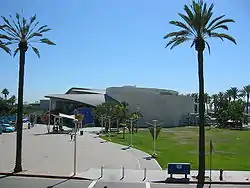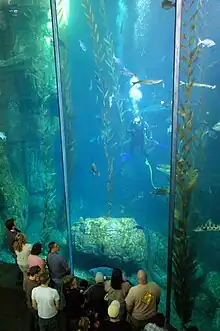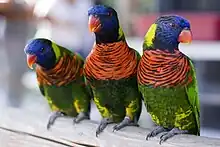Aquarium of the Pacific
The Aquarium of the Pacific (formerly the Long Beach Aquarium of the Pacific[3]) is a public aquarium on a 5-acre (20,000 m2) site on Rainbow Harbor in Long Beach, California, United States. It is situated across the water from the Long Beach Convention Center, Shoreline Village, and the Queen Mary Hotel and Attraction.[6]
| Aquarium of the Pacific | |
|---|---|
 | |
 Former walkway to the aquarium | |
| 33.76216°N 118.19692°W | |
| Date opened | June 20, 1998[1] |
| Location | Long Beach, California, United States |
| No. of animals | 11,000[2] |
| No. of species | 500[2] |
| Volume of largest tank | 350,000 US gallons (1,300,000 L)[3] |
| Annual visitors | 1.7 million[4] |
| Memberships | AZA[5] |
| Major exhibits | Coral Reefs: Nature's Underwater Cities, June Keyes Penguin Habitat, Lorikeet Forest, Northern Pacific Gallery, Shark Lagoon, Southern California/Baja Gallery, Tropical Pacific Gallery, Frogs: Dazzling and Disappearing, Sea Otter Habitat[2] |
| Public transit access | |
| Website | www |
The aquarium sees 1.5 million visitors a year and has a total staff of about 1,875 people, including more than 1,500 volunteers and about 375 employees.[6][7] It is a 501(c)(3) non-profit aquarium.[6]
The aquarium is an accredited member of the Association of Zoos and Aquariums (AZA).[5]
The aquarium also has a website where you can purchase admission tickets, and watch live webcams of the exhibits.
Exhibits
The aquarium features a collection of over 11,000 animals, representing over 500 different species, in exhibits ranging in size and capacity from about 5,000 to 350,000 gallons.[3]
The Pacific Ocean is the focus of three major permanent galleries, Southern California and Baja, the Northern Pacific, and the Tropical Pacific.[2] These exhibits introduce the inhabitants and seascapes of the Pacific, while also focusing on the specific conservation messages associated with each region.

Southern California & Baja Gallery
The Southern California & Baja Gallery features the varied habitats of this region. The first exhibit is the 142,000-US-gallon (540,000 L) three-story Blue Cavern tank, which houses animals that live in the waters surrounding nearby Catalina Island. Next is the Amber Forest exhibit, which replicates a Giant kelp forest with Garibaldi, California scorpionfish, and other representative organisms.[8] The Gulf of California exhibit houses Cortez rainbow wrasse, Mexican lookdowns, porcupine fish, and others.[9] Other areas of the gallery include the 211,000-US-gallon (800,000 L) Seal and Sea Lion Habitat, Ray Touch Pool, and Shorebird Sanctuary.[8]
Northern Pacific Gallery
The Northern Pacific Gallery focuses on organisms from the Bering Sea.[10] Exhibits include the Sea Otter Habitat, home to southern sea otters;[11] the giant Pacific octopus tank; and Diving Birds, where puffins and auklets live. Other species on display include Japanese spider crabs, jellyfish, and sea anemones.[10]
Tropical Pacific Gallery
The Tropical Pacific Gallery exhibits animals off the coast of the islands of Palau and has the aquarium's largest tank, the 350,000-US-gallon (1,300,000 L) Tropical Reef Habitat. This tank houses olive ridley sea turtles, zebra sharks, and many other species. Elsewhere in the Gallery are big-belly seahorses, leafy seadragons, weedy seadragons, and sea kraits.[12]
Explorer's Cove

The aquarium's main outdoor area, Explorer's Cove, encompasses the Shark Lagoon and Lorikeet Forest, Moon Jellies and The Steel Trout/Rainbow Trout tank. Also available are shops with aquarium merchandise and even a smoothie shop that offers a variety of smoothies and small snacks.
Shark Lagoon
This 10,000-square-foot (930 m2) exhibit area houses over 150 sharks and rays. The main tank houses larger spec rays, blacktip reef sharks, grey reef sharks, zebra sharks, and a sand tiger shark, while the more docile bamboo and epaulette sharks live in the three touch pools.[13] Guests are able to touch these sharks and rays with two fingers as directed by the volunteers and staff.
Lorikeet Forest
The Lorikeet Forest is a walk-through aviary that covers 3,200 square feet (300 m2) and houses five subspecies of rainbow lorikeet as well as the violet-necked lory. Guests may feed them small amounts of nectar for a fee.[14]
June Keyes Penguin Habitat
This exhibit for the Magellanic penguin opened in May 2012. An underwater crawl-in space allows guests to view the penguins from within the tank.[15]
Pacific Visions
In 2018, the aquarium opened a new wing named Pacific Visions, which houses a 266-seat 4D theater with a 30 foot tall, 180 degree wraparound screen. The film is 8 minutes long, and free with aquarium admission. The wing also features new animal exhibits, including a cleaner shrimp touch tank, and several interactive art installations.
Seals and Sea Lions Habitat
This habitat is home to the aquarium's Sea Lions as well as Harbor Seals. These seals often perform shows that are very informational about the seals. There are opportunities for guests to actually go into the habitat and feed the seals sardines. For guests still in the stands you may see the seals perform tricks or let out very loud yells that are entertaining to witness.
Other attractions
In spring 2010, the aquarium opened a new 4,700-square-foot (440 m2) Earth-Friendly Garden on its front lawn. The garden features California native and drought-resistant plants, as well as a very efficient irrigation system, to show part of the solution to Southern California's ongoing water shortage problems.[16]
Activities
The Aquarium of the Pacific's marine science and conservation ventures include: breeding and conservation programs for endangered marine animals and habitats; housing of unreleasable seals, sea lions, and sea otters from local care centers and marine parks; beach and habitat cleanups; a variety of green business practices; and continuing efforts to educate visitors on the importance the ocean, its threats, and conservation, including the hazards of marine pollution, over-harvesting, habitat destruction and global climate change. One example is a trashion festival with works by Marina DeBris educating about ocean pollution.[17]
The Aquarium of the Pacific is also home to many cultural events throughout the year, such as the Pacific Islander Festival in the summer, the Moompetam Festival in the fall, special treats for the animals at Christmas, the Festival of Human Abilities in January, and the African Heritage Festival in February.
In partnership with some of the local whale watching tourboats guests are able to buy bundle tickets that allow for admission into the aquarium and a three hour long trip into the Pacific Ocean off the Californian coast. Guests have the opportunity to see many different whales, dolphins and other sealife. Most commonly seen are Gray Whales, Humpback Whales and Bottlenose Dolphins.
Architecture

The aquarium architecture is inspired by the towering, breaking waves of the Pacific and mirrors the fluid and dynamic temper of the ocean. Kajima International, developers of the world's most critically acclaimed and technologically advanced aquariums, was the developer of the Aquarium of the Pacific and architects included the Los Angeles office of Hellmuth, Obata & Kassanbaum and Esherick Homsey Dodge and Davis of San Francisco. Construction was a joint venture of Turner Construction Company and Kajima International. On June 20, 1998, construction was completed and the aquarium opened to the public.[18]
Gallery
 Entrance to tropical gallery, designed to replicate a tropical coral reef lagoon
Entrance to tropical gallery, designed to replicate a tropical coral reef lagoon California sea lion during training session
California sea lion during training session Top of 350,000 gallon tropical habitat, viewable only during behind the scenes tours
Top of 350,000 gallon tropical habitat, viewable only during behind the scenes tours
References
- "Remembering Grand Opening Day". aquariumofpacific.org. Aquarium of the Pacific. 17 June 2008. Archived from the original on 6 December 2012. Retrieved 5 December 2012.
- "Aquarium Exhibits". aquariumofpacific.org. Aquarium of the Pacific. Archived from the original on 7 November 2010. Retrieved 5 December 2012.
- "The Long Beach Aquarium of the Pacific". visit-los-angeles.com. Analytical Software Packages, Inc. Archived from the original on 17 July 2011. Retrieved 5 December 2012.
- Abel, David (2016-08-02). "Top aquariums in the US, in terms of visitors". Boston Globe. Retrieved 2016-12-02.
- "Currently Accredited Zoos and Aquariums". aza.org. AZA. Retrieved May 1, 2012.
- "2017 Annual Report" (PDF). aquariumofpacific.org. Aquarium of the Pacific. Retrieved 4 June 2019.
- "Aquarium of the Pacific Institutional Fact Sheet" (PDF). aquariumofpacific.org. Aquarium of the Pacific. Retrieved 4 June 2019.
- "Southern California/Baja Gallery". aquariumofpacific.org. Aquarium of the Pacific. Archived from the original on 22 July 2011. Retrieved 14 November 2012.
- "Gulf of California". aquariumofpacific.org. Aquarium of the Pacific. Retrieved 14 November 2012.
- "Northern Pacific Gallery". aquariumofpacific.org. Aquarium of the Pacific. Archived from the original on 23 June 2011. Retrieved 29 November 2012.
- "BP Sea Otter Habitat". aquariumofpacific.org. Aquarium of the Pacific. Retrieved 29 November 2012.
- "Northern Pacific Gallery". aquariumofpacific.org. Aquarium of the Pacific. Archived from the original on 23 June 2011. Retrieved 29 November 2012.
- "Shark Lagoon". aquariumofpacific.org. Aquarium of the Pacific. Archived from the original on 22 July 2011. Retrieved 5 December 2012.
- "Lorikeet Forest". aquariumofpacific.org. Aquarium of the Pacific. Archived from the original on 23 June 2011. Retrieved 5 December 2012.
- "Magellanic Penguins Go On Exhibit May 17". aquariumofpacific.org. Aquarium of the Pacific. 1 May 2012. Archived from the original on 6 December 2012. Retrieved 5 December 2012.
- "New Earth-Friendly Garden Opens at the Aquarium". aquariumofpacific.org. Aquarium of the Pacific. 22 April 2010. Archived from the original on 27 September 2011. Retrieved 5 December 2012.
- Bennett, Sarah (3 May 2012). "Aquarium's Urban Ocean Festival Educates With Trash Fashion, Local Seafood and Art". Long Beach Post. Archived from the original on 10 April 2017. Retrieved 9 April 2017.
- "Aquarium of the Pacific - Long Beach, CA". beachcalifornia.com. BeachCalifornia.com. Retrieved 5 December 2012.
External links
 Media related to Aquarium of the Pacific at Wikimedia Commons
Media related to Aquarium of the Pacific at Wikimedia Commons- Official website